Neuroprotective Effect of Gold Nanoparticles and Alpha-Lipoic Acid Mixture against Radiation-Induced Brain Damage in Rats
Abstract
1. Introduction
2. Results
2.1. Characterization of Gold Nanoparticles
2.1.1. Ultraviolet/Visible Spectroscopy
2.1.2. Zeta Potential Analysis
2.1.3. X-ray Diffraction Analysis
2.1.4. Energy Dispersive Spectroscopy Analysis
2.1.5. Dynamic Light Scattering
2.1.6. Transmission Electron Microscopy
2.1.7. Fourier Transform Infrared Spectroscopy
2.2. Results of the Preliminary Experiment
2.2.1. Effect of Single Oral Administration of Different Doses of AuNPs on MDA Content in Cortical and Hippocampal Tissues of 7Gy-Irradiated Rats
2.2.2. Effect of Single Oral Administration of Different Doses of AuNPs on GPX Activity in Cortical and Hippocampal Tissues of 7Gy-Irradiated Rats
2.2.3. Effect of Single Oral Administration of Different Doses of AuNPs on DNA Fragmentation in Cortical and Hippocampal Tissues of 7Gy-Irradiated Rats
2.2.4. Effect of Single Oral Administration of Different Doses of AuNPs on Histopathological Changes in Cortical and Hippocampal Tissues of 7Gy-Irradiated Rats
2.3. Results of the Main Experiment
2.3.1. Effect of AuNPs-ALA Mixture’s Single Oral Administration on MDA Content in Cortical and Hippocampal Tissues of 7Gy-Irradiated Rats
2.3.2. Effect of AuNPs-ALA Mixture’s Single Oral Administration on GPX Activity in Cortical and Hippocampal Tissues of 7Gy-Irradiated Rats
2.3.3. Effect of AuNPs-ALA Mixture’s Single Oral Administration on DNA Fragmentation in Cortical and Hippocampal Tissues of 7Gy-Irradiated Rats
2.3.4. Effect of Single Oral Administration of AuNPs-ALA Mixture on Histopathological Changes in Cortical and Hippocampal Tissues of 7Gy-Irradiated Rats
3. Discussion
4. Materials and Methods
4.1. Bioethical Statement
4.2. Chemicals and Drugs
4.3. Preparation of Gold Nanoparticles
4.4. Preparation of Drugs’ Solutions
4.5. Gold Nanoparticles’ Characterization
4.5.1. Ultraviolet/Visible Spectroscopy
4.5.2. Zeta Potential Analysis
4.5.3. X-ray Diffraction Analysis
4.5.4. Energy Dispersive Spectroscopy
4.5.5. Dynamic Light Scattering
4.5.6. Transmission Electron Microscopy
4.5.7. Fourier Transform Infrared Spectroscopy
4.6. Irradiation of Animals
4.7. Experimental Design
- Group I: rats received a single oral dose of saline.
- Group II: normal rats were irradiated with a single dose of 7Gy gamma radiation.
- Group III: normal rats get 500 µg/kg AuNPs’ single oral dose.
- Group IV: normal rats get 1000 µg/kg AuNPs’ single oral dose.
- Group V: normal rats get 1500 µg/kg AuNPs’ single oral dose.
- Group VI: irradiated rats get 500 µg/kg AuNPs’ single oral dose.
- Group VII: irradiated rats get 1000 µg/kg AuNPs’ single oral dose.
- Group VIII: irradiated rats get 1500 µg/kg AuNPs’ single oral dose.
- Group I: normal rats get the vehicle’s single oral dose.
- Group II: normal rats get 200 mg/Kg VPA’s single oral dose.
- Group III: normal rats get 100 mg/kg ALA’s single oral dose.
- Group IV: normal rats get 1000 µg/kg AuNPs’ single oral dose.
- Group V: normal rats get freshly prepared AuNPs-ALA mixture’s single oral dose (mixture of 100 mg/kg ALA and 1000 µg/kg AuNPs).
- Group VI: normal rats irradiated with a single dose of 7Gy gamma radiation.
- Group VII: irradiated rats get 200 mg/Kg VPA’s single oral dose.
- Group VIII: irradiated rats get 100 mg/kg ALA’s single oral dose.
- Group IX: irradiated rats get 1000 µg/kg AuNPs’ single oral dose.
- Group X: irradiated rats get freshly prepared AuNPs-ALA mixture’s single oral dose.
4.8. Colorimetric Assays
4.9. DNA Fragmentation
4.10. Histopathological Examination
4.11. Statistical Analysis
5. Conclusions
Author Contributions
Funding
Institutional Review Board Statement
Informed Consent Statement
Data Availability Statement
Acknowledgments
Conflicts of Interest
References
- Tsao, M.N.; Lloyd, N.S.; Wong, R.K.S. Clinical practice guideline on the optimal radiotherapeutic management of brain metastases. BMC Cancer 2005, 5, 34. [Google Scholar] [CrossRef] [PubMed]
- Khuntia, D.; Brown, P.; Li, J.; Mehta, M.P. Whole-brain radiotherapy in the management of brain metastasis. J. Clin. Oncol. 2006, 24, 1295–1304. [Google Scholar] [CrossRef] [PubMed]
- Wang, Q.; Xie, C.; Xi, S.; Qian, F.; Peng, X.; Huang, J.; Tang, F. Radioprotective Effect of Flavonoids on Ionizing Radiation-Induced Brain Damage. Molecules 2020, 25, 5719. [Google Scholar] [CrossRef]
- Kim, S.H.; Lim, D.J.; Chung, Y.G.; Cho, T.H.; Lim, S.J.; Kim, W.J.; Suh, J.K. Expression of TNF-alpha and TGF-beta1 in the Rat Brain After a Single High-Dose Irradiation. J. Korean Med. Sci. 2002, 17, 242–248. [Google Scholar] [CrossRef] [PubMed]
- Gaber, M.W.; Sabek, O.M.; Fukatsu, K.; Wilcox, H.G.; Kiani, M.F.; Merchant, T.E. Differences in ICAM-1 and TNF-α expression between large single fraction and fractionated irradiation in mouse brain. Int. J. Radiat. Biol. 2003, 79, 359–366. [Google Scholar] [CrossRef] [PubMed]
- Jeggo, P.; Löbrich, M. Radiation-induced DNA damage responses. Radiat. Prot. Dosim. 2006, 122, 124–127. [Google Scholar] [CrossRef] [PubMed]
- Huynh, N.H.; Chow, J.C.L. DNA Dosimetry with Gold Nanoparticle Irradiated by Proton Beams: A Monte Carlo Study on Dose Enhancement. App. Sci. Vol. 2021, 11, 10856. [Google Scholar] [CrossRef]
- Jabeen, M.; Chow, J.C.L. Gold Nanoparticle DNA Damage by Photon Beam in a Magnetic Field: A Monte Carlo Study. Nanomaterials 2021, 11, 1751. [Google Scholar] [CrossRef] [PubMed]
- Saraiva, C.; Praça, C.; Ferreira, R.; Santos, T.; Ferreira, L.; Bernardino, L. Nanoparticle-mediated brain drug delivery: Overcoming blood–brain barrier to treat neurodegenerative diseases. J. Control. Release 2016, 235, 34–47. [Google Scholar] [CrossRef]
- Mukherjee, P.; Bhattacharya, R.; Wang, P.; Wang, L.; Basu, S.; Nagy, J.A.; Atala, A.; Mukhopadhyay, D.; Soker, S. Antiangiogenic properties of gold nanoparticles. Clin. Cancer Res. 2005, 11, 3530–3534. [Google Scholar] [CrossRef]
- Reddy, V.R. Gold nanoparticles: Synthesis and applications. Synlett 2006, 11, 1791–1792. [Google Scholar] [CrossRef][Green Version]
- Boisselier, E.; Astruc, D. Gold nanoparticles in nanomedicine: Preparations, imaging, diagnostics, therapies and toxicity. Chem. Soc. Rev. 2009, 38, 1759–1782. [Google Scholar] [CrossRef] [PubMed]
- Tsai, C.; Shiau, A.; Chen, S.; Chen, Y.; Cheng, P.; Chang, M.; Chen, D.; Chou, C.; Wang, C.; Wu, C. Amelioration of collagen-induced arthritis in rats by nanogold, Arthritis Rheum. Off. J. Am. Coll. Rheumatol. 2007, 56, 544–554. [Google Scholar]
- Barathmanikanth, S.; Kalishwaralal, K.; Sriram, M.; Pandian, S.R.K.; Youn, H.; Eom, S.; Gurunathan, S. Anti-oxidant effect of gold nanoparticles restrains hyperglycemic conditions in diabetic mice. J. Nanobiotechnol. 2010, 8, 16. [Google Scholar] [CrossRef] [PubMed]
- Kajita, M.; Hikosaka, K.; Iitsuka, M.; Kanayama, A.; Toshima, N.; Miyamoto, Y. Platinum nanoparticle is a useful scavenger of superoxide anion and hydrogen peroxide. Free Radic. Res. 2007, 41, 615–626. [Google Scholar] [CrossRef]
- Siddique, S.; Chow, J.C.L. Gold Nanoparticles for Drug Delivery and Cancer Therapy. App. Sci. 2020, 10, 3824. [Google Scholar] [CrossRef]
- Moore, J.A.; Chow, J.C.L. Recent Progress and Applications of Gold Nanotechnology in Medical Biophysics Using Artificial Intelligence and Mathematical Modeling. Nano Express 2021, 2, 22001. [Google Scholar] [CrossRef]
- Ramachandran, L.; Nair, C.K.K. Therapeutic potentials of silver nanoparticle complex of α-lipoic acid. Nanomater. Nanotechnol. 2011, 1, 14. [Google Scholar] [CrossRef]
- Monti, B.; Polazzi, E.; Contestabile, A. Biochemical, molecular and epigenetic mechanisms of valproic acid neuroprotection. Curr. Mol. Pharmacol. 2009, 2, 95–109. [Google Scholar] [CrossRef]
- Abdel-Wahab, B.A.; Metwally, M.E. Protective effect of alpha lipoic acid against lead-induced hippocampal neurotoxicity and neuronal oxidative stress in rats. Austin J. Pharmacol. Ther. 2014, 2, 8. [Google Scholar]
- El-Batal, A.I.; Haroun, B.M.; Farrag, A.A.; Baraka, A.; El-Sayyad, G. Synthesis of silver nanoparticles and incorporation with certain antibiotic using gamma irradiation. Br. J. Pharmac. Res. 2014, 4, 1341–1363. [Google Scholar] [CrossRef]
- Gurunathan, S.; Han, J.; Park, J.H.; Kim, J.-H. A green chemistry approach for synthesizing biocompatible gold nanoparticles. Nanoscale Res. Lett. 2014, 9, 248. [Google Scholar] [CrossRef] [PubMed]
- Neshastehriz, A.; Tabei, M.; Maleki, S.; Eynali, S.; Shakeri-Zadeh, A. Photothermal therapy using folate conjugated gold nanoparticles enhances the effects of 6 MV X-ray on mouth epidermal carcinoma cells. J. Photochem. Photobiol. B Biol. 2017, 172, 52–60. [Google Scholar] [CrossRef] [PubMed]
- GotI, P.P.; Savsani, J.J.; Patel, P.B. Spectrophotometric method development and validation for estimation of α-lipoic acid in tablet dosage form. Int. J. Pharm. Pharm. Sci. 2012, 4, 519–522. [Google Scholar]
- Amarnath, K.; Mathew, N.L.; Nellore, J.; Siddarth, C.R.; Kumar, J. Facile synthesis of biocompatible gold nanoparticles from Vites vinefera and its cellular internalization against HBL-100 cells. Cancer Nanotechnol. 2011, 2, 121–132. [Google Scholar] [CrossRef]
- Toulbe, N.; Stroe, M.S.; Daescu, M.; Cercel, R.; Mogos, A.; Dragoman, D.; Socol, M.; Mercioniu, I.; Baibarac, M. Reduced Graphene Oxide Sheets as Inhibitors of the Photochemical Reactions of α-Lipoic Acid in the Presence of Ag and Au Nanoparticles. Nanomaterials 2020, 10, 2238. [Google Scholar] [CrossRef]
- Walter, M.; Akola, J.; Lopez-Acevedo, O.; Jadzinsky, P.D.; Calero, G.; Ackerson, C.J.; Whetten, R.L.; Grönbeck, H.; Häkkinen, H. A unified view of ligand-protected gold clusters as superatom complexes. Proc. Natl. Acad. Sci. USA 2008, 105, 9157–9162. [Google Scholar] [CrossRef]
- Cheng, L.; Ren, C.; Zhang, X.; Yang, J. New insight into the electronic shell of Au(38)(SR)(24): A superatomic molecule. Nanoscale 2013, 5, 1475–1478. [Google Scholar] [CrossRef]
- Bryant, M.A.; Pemberton, J.E. Surface Raman Scattering of Self-Assembled Monolayers Formed from 1-Alkanethiols: Behavior of Films at Gold and Comparison to Films at Silver. J. Am. Chem. Soc. 1991, 113, 8284–8293. [Google Scholar] [CrossRef]
- Turcu, I.; Zarafu, I.; Popa, M.; Chifiriuc, M.C.; Bleotu, C.; Culita, D.; Ghica, C.; Ionita, P. Lipoic acid gold nanoparticles functionalized with organic compounds as bioactive materials. Nanomaterials 2017, 7, 43. [Google Scholar] [CrossRef]
- Chandraker, K.; Vaishanav, S.K.; Nagwanshi, R.; Satnami, M.L. Radical scavenging efficacy of thiol capped silver nanoparticles. J. Chem. Sci. 2015, 127, 2183–2191. [Google Scholar] [CrossRef]
- Inaga, S.; Osatake, H.; Tanaka, K. SEM images of DNA double helix and nucleosomes observed by ultrahigh-resolution scanning electron microscopy. Microscopy 1991, 40, 181–186. [Google Scholar]
- Hobot, J.; Walker, M.; Newman, G.; Bowler, P. Effect of Hydrofiber® wound dressings on bacterial ultrastructure. J. Electron. Microsc. 2008, 57, 67–75. [Google Scholar] [CrossRef] [PubMed]
- Sharma, N.; Bhatt, G.; Kothiyal, P. Gold nanoparticles synthesis, properties, and forthcoming applications-a review. Indian J. Pharm. Biol. Res. 2015, 3, 13. [Google Scholar] [CrossRef]
- Pinho, R.A.; Haupenthal, D.P.; Fauser, P.E.; Thirupathi, A.; Silveira, P.C. Gold nanoparticle-based therapy for muscle inflammation and oxidative stress. J. Inflamm. Res. 2022, 15, 3219. [Google Scholar] [CrossRef]
- Krishnamurthy, S.; Esterle, A.; Sharma, N.C.; Sahi, S.V. Yucca-derived synthesis of gold nanomaterial and their catalytic potential. Nanoscale Res. Lett. 2014, 9, 627. [Google Scholar] [CrossRef]
- Papa, F.; Dobrescu, G.; Munteanu, C.; Atkinson, I.; Balint, I.; Volceanov, A. Green synthesis and characterization of gold nanoparticles obtained by a direct reduction method and their fractal dimension. Environ. Eng. Manag. J. 2015, 14, 587–593. [Google Scholar]
- Sneha, K.; Sathishkumar, M.; Kim, S.; Yun, Y.S. Counter ions and temperature incorporated tailoring of biogenic gold nanoparticles. Process. Biochem. 2010, 45, 1450–1458. [Google Scholar] [CrossRef]
- Medina-Ramírez, I.; González-García, M.; Liu, J.L. Nanostructure characterization of polymer-stabilized gold nanoparticles and nanofilms derived from green synthesis. J. Mater. Sci. 2009, 44, 6325–6332. [Google Scholar] [CrossRef]
- Viet Long, N.; Ohtaki, M.; Yuasa, M.; Yoshida, S.; Kuragaki, T.; Minh Thi, C.; Nogami, M. Synthesis and self-assembly of gold nanoparticles by chemically modified polyol methods under experimental control. J. Nanomater. 2013, 2013, 793125. [Google Scholar] [CrossRef]
- El-Batal, A.I.; Al Tamie, M.S. Biosynthesis of gold nanoparticles using marine Streptomyces cyaneus and their antimicrobial, antioxidant and antitumor (in vitro) activities. J. Chem. Pharm. Res. 2015, 7, 1020–1036. [Google Scholar]
- Teeparuksapun, K.; Prasongchan, N.; Thawonsuwan, A. Alpha-lipoic acid functionalized silver nanoparticles for colorimetric detection of copper ion. Anal. Sci. 2019, 35, 371–377. [Google Scholar] [CrossRef] [PubMed]
- Tran, M.T. Synthesis and Properties of Lipoic Acid Stabilized Gold Nanoclusters. Master’s Thesis, Georgia State University, Atlanta, GA, USA, 2019. [Google Scholar]
- Suganthi, K.S.; Anusha, N.; Rajan, K.S. Low viscous ZnO–propylene glycol nanofluid: A potential coolant candidate. J. Nanoparticle Res. 2013, 15, 1986. [Google Scholar] [CrossRef]
- Chaudhari, S.P.; Chatur, M.V. Development of Valproic Acid Niosomal in Situ Nasal Gel Formulation for Epilepsy. Ind. J. Pharma. Edu. Res. 2013, 16, 31–41. [Google Scholar] [CrossRef]
- Michaels, H.B.; Hunt, J.W. A model for radiation damage in cells by direct effect and by indirect effect: A radiation chemistry approach. Radiat. Res. 1978, 74, 23–34. [Google Scholar] [CrossRef]
- Halliwell, B. Oxidative stress and neurodegeneration: Where are we now? J. Neurochem. 2006, 97, 1634–1658. [Google Scholar] [CrossRef]
- Abdel-Fattah, K.I.; El-Gawish, M.A.; Abou-Safi, H.M. Protective effect of exogenous dehydro-epiandrosterone Sulfate (DHEAS) on liver cell organs of whole body y-irradiated rats, Egypt. J. Radiat. Sci. Appl. 2005, 18, 277–292. [Google Scholar]
- Kilciksiz, S.; Demirel, C.; Erdal, N.; Gürgül, S.; Tamer, L.; Ayaz, L.; Örs, Y. The effect of N-acetylcysteine on biomarkers for radiation-induced oxidative damage in a rat model. Acta Med. Okayama. 2008, 62, 403–409. [Google Scholar]
- Ismail, A.F.M.; Salem, A.A.M.; Eassawy, M.M.T. Modulation of gamma-irradiation and carbon tetrachloride induced oxidative stress in the brain of female rats by flaxseed oil. J. Photochem. Photobiol. B Biol. 2016, 161, 91–99. [Google Scholar] [CrossRef] [PubMed]
- Kamat, J.P.; Boloor, K.K.; Devasagayam, T.P.A.; Venkatachalam, S.R. Antioxidant properties of Asparagus racemosus against damage induced by γ-radiation in rat liver mitochondria. J. Ethnopharmacol. 2000, 71, 425–435. [Google Scholar] [CrossRef]
- Dkhil, M.A.; Bauomy, A.A.; Diab, M.S.M.; Wahab, R.; Delic, D.; Al-Quraishy, S. Impact of gold nanoparticles on brain of mice infected with Schistosoma mansoni. Parasitol. Res. 2015, 114, 3711–3719. [Google Scholar] [CrossRef]
- Hoo, R.; Nakimuli, A.; Vento-Tormo, R. Innate immune mechanisms to protect against infection at the human decidual-placental interface. Front. Immunol. 2020, 11, 2070. [Google Scholar] [CrossRef] [PubMed]
- Aengenheister, L.; Favaro, R.R.; Morales-Prieto, D.M.; Furer, L.A.; Gruber, M.; Wadsack, C.; Markert, U.R.; Buerki-Thurnherr, T. Research on nanoparticles in human perfused placenta: State of the art and perspectives. Placenta 2021, 104, 199–207. [Google Scholar] [CrossRef] [PubMed]
- Myllynen, P.K.; Loughran, M.J.; Howard, C.V.; Sormunen, R.; Walsh, A.A.; Vähäkangas, K.H. Kinetics of gold nanoparticles in the human placenta. Reprod. Toxicol. 2008, 26, 130–137. [Google Scholar] [CrossRef] [PubMed]
- Dos Santos Tramontin, N.; da Silva, S.; Arruda, R.; Ugioni, K.S.; Canteiro, P.B.; de Bem Silveira, G.; Mendes, C.; Silveira, P.C.L.; Muller, A.P. Gold nanoparticles treatment reverses brain damage in Alzheimer’s disease model. Mol. Neurobiol. 2020, 57, 926–936. [Google Scholar] [CrossRef]
- Zhao, J.; Xu, N.; Yang, X.; Ling, G.; Zhang, P. The roles of gold nanoparticles in the detection of amyloid-β peptide for Alzheimer’s disease. Colloid Interface Sci. Commun. 2022, 46, 100579. [Google Scholar] [CrossRef]
- Pan, Y.; Neuss, S.; Leifert, A.; Fischler, M.; Wen, F.; Simon, U.; Schmid, G.; Brandau, W.; Jahnen-Dechent, W. Size-dependent cytotoxicity of gold nanoparticles. Small 2007, 3, 1941–1949. [Google Scholar] [CrossRef]
- Jagetia, G.C. Radioprotective potential of plants and herbs against the effects of ionizing radiation. J. Clin. Biochem. Nutr. 2007, 40, 74–81. [Google Scholar] [CrossRef]
- Sen, G.T.; Ozkemahli, G.; Shahbazi, R.; Erkekoglu, P.; Ulubayram, K.; Kocer-Gumusel, B. The effects of polymer coating of gold nanoparticles on oxidative stress and DNA damage. Int. J. Toxicol. 2020, 39, 328–340. [Google Scholar] [CrossRef]
- Schmid, G. The relevance of shape and size of Au 55 clusters. Chem. Soc. Rev. 2008, 37, 1909–1930. [Google Scholar] [CrossRef]
- Siddiqi, N.J.; Abdelhalim, M.A.K.; El-Ansary, A.K.; Alhomida, A.S.; Ong, W.Y. Identification of potential biomarkers of gold nanoparticle toxicity in rat brains. J. Neuroinflamm. 2012, 9, 123. [Google Scholar] [CrossRef] [PubMed]
- Sanati, M.; Khodagholi, F.; Aminyavari, S.; Ghasemi, F.; Gholami, M.; Kebriaeezadeh, A.; Sabzevari, O.; Hajipour, M.J.; Imani, M.; Mahmoudi, M.; et al. Impact of Gold Nanoparticles on Amyloid β-Induced Alzheimer’s Disease in a Rat Animal Model: Involvement of STIM Proteins. ACS Chem. Neurosci. 2019, 10, 2299–2309. [Google Scholar] [CrossRef]
- Dong, Y.; Wan, G.; Yan, P.; Qian, C.; Li, F.; Peng, G. Fabrication of resveratrol coated gold nanoparticles and investigation of their effect on diabetic retinopathy in streptozotocin induced diabetic rats. J. Photochem. Photobiol. B Biol. 2019, 195, 51–57. [Google Scholar] [CrossRef] [PubMed]
- Ghanizadeh, A. Gold nanoparticles and lipoic acid as a novel anti-inflammatory treatment for autism, a hypothesis. J. Med. Hypotheses Ideas 2012, 6, 40–43. [Google Scholar] [CrossRef]
- Leu, J.-G.; Chen, S.-A.; Chen, H.-M.; Wu, W.-M.; Hung, C.-F.; Yao, Y.-D.; Tu, C.-S.; Liang, Y.-J. The effects of gold nanoparticles in wound healing with antioxidant epigallocatechin gallate and α-lipoic acid. Nanomed. Nanotechnol. Biol. Med. 2012, 8, 767–775. [Google Scholar] [CrossRef]
- Gorąca, A.; Asłanowicz-Antkowiak, K. Prophylaxis with α-lipoic acid against lipopolysaccharide-induced brain injury in rats. Arch. Immunol. Ther. Exp. 2009, 57, 141–146. [Google Scholar] [CrossRef]
- Della Giustina, A.; Goldim, M.P.; Danielski, L.G.; Florentino, D.; Mathias, K.; Garbossa, L.; Junior, A.N.O.; Fileti, M.E.; Zarbato, G.F.; da Rosa, N. Alpha-lipoic acid attenuates acute neuroinflammation and long-term cognitive impairment after polymicrobial sepsis. Neurochem. Int. 2017, 108, 436–447. [Google Scholar] [CrossRef]
- De Freitas, R.M. Lipoic acid alters δ-aminolevulinic dehydratase, glutathione peroxidase and Na+, K+-ATPase activities and glutathione-reduced levels in rat hippocampus after pilocarpine-induced seizures. Cell. Mol. Neurobiol. 2010, 30, 381–387. [Google Scholar] [CrossRef]
- Shirpoor, A.; Minassian, S.; Salami, S.; Khadem-Ansari, M.H.; Yeghiazaryan, M. Alpha-lipoic acid decreases DNA damage and oxidative stress induced by alcohol in the developing hippocampus and cerebellum of rat. Cell. Physiol. Biochem. 2008, 22, 769–776. [Google Scholar] [CrossRef]
- Toklu, H.Z.; Hakan, T.; Celik, H.; Biber, N.; Erzik, C.; Ogunc, A.V.; Akakin, D.; Cikler, E.; Cetinel, S.; Ersahin, M. Neuroprotective effects of alpha-lipoic acid in experimental spinal cord injury in rats. J. Spinal Cord Med. 2010, 33, 401–409. [Google Scholar] [CrossRef][Green Version]
- Jia, Z.; Zhu, H.; Vitto, M.J.; Misra, B.R.; Li, Y.; Misra, H.P. Alpha-lipoic acid potently inhibits peroxynitrite-mediated DNA strand breakage and hydroxyl radical formation: Implications for the neuroprotective effects of alpha-lipoic acid. Mol. Cell. Biochem. 2009, 323, 131–138. [Google Scholar] [CrossRef] [PubMed]
- Arivazhagan, P.; Panneerselvam, C. Effect of DL-α-lipoic acid on tissue nucleic acid contents in aged rats. Pharmacol. Res. 2000, 42, 223–226. [Google Scholar] [CrossRef] [PubMed]
- Choi, K.H.; Park, M.S.; Kim, H.S.; Kim, K.T.; Kim, H.S.; Kim, J.T.; Kim, B.C.; Kim, M.K.; Park, J.T.; Cho, K.H. Alpha-lipoic acid treatment is neurorestorative and promotes functional recovery after stroke in rats. Mol. Brain. 2015, 8, 9. [Google Scholar] [CrossRef]
- Manda, K.; Ueno, M.; Moritake, T.; Anzai, K. Radiation-induced cognitive dysfunction and cerebellar oxidative stress in mice: Protective effect of α-lipoic acid. Behav. Brain Res. 2007, 177, 7–14. [Google Scholar] [CrossRef] [PubMed]
- El-Drieny, E.A.; Sarhan, N.I.; Bayomy, N.A.; Elsherbeni, S.A.E.; Momtaz, R.; Mohamed, H.E.-D. Histological and immunohistochemical study of the effect of gold nanoparticles on the brain of adult male albino rat. J. Microsc. Ultrastruct. 2015, 3, 181–190. [Google Scholar]
- Dong, J.; Carpinone, P.L.; Pyrgiotakis, G.; Demokritou, P.; Moudgil, B.M. Synthesis of precision gold nanoparticles using Turkevich method. KONA Powder Part. J. 2020, 37, 224–232. [Google Scholar] [CrossRef]
- Brufani, M.; Figliola, R. (R)-α-lipoic acid oral liquid formulation: Pharmacokinetic parameters and therapeutic efficacy. Acta Bio-Med. Atenei Parm. 2014, 85, 108–115. [Google Scholar]
- Zaky, A.; Mahmoud, M.; Awad, D.; El Sabaa, B.M.; Kandeel, K.M.; Bassiouny, A.R. Valproic acid potentiates curcumin-mediated neuroprotection in lipopolysaccharide induced rats. Front. Cell. Neurosci. 2014, 8, 337. [Google Scholar] [CrossRef]
- Noor, N.A.; Fahmy, H.M.; Mourad, I.M. Evaluation of the potential neurotoxicity of gold nanoparticles in the different rat brain regions. Int. J. Sci. Basic Appl. Res. 2016, 30, 114–129. [Google Scholar]
- Elkodous, M.A.; El-Sayyad, G.S.; Mohamed, A.E.; Pal, K.; Asthana, N.; de Souza Junior, F.G.; Mosallam, F.M.; Gobara, M.; El-Batal, A.I. Layer-by-Layer Preparation and Characterization of Recyclable Nanocomposite (CoxNi1− XFe2O4; X = 0.9/SiO2/TiO2). J. Mater. Sci. Mater. Electron. 2019, 30, 8312–8328. [Google Scholar] [CrossRef]
- El-Batal, A.I.; Abd Elkodous, M.; El-Sayyad, G.S.; Al-Hazmi, N.E.; Gobara, M.; Baraka, A. Gum Arabic polymer-stabilized and Gamma rays-assisted synthesis of bimetallic silver-gold nanoparticles: Powerful antimicrobial and antibiofilm activities against pathogenic microbes isolated from diabetic foot patients. Int. J. Biol. Macromol. 2020, 165, 169–186. [Google Scholar] [CrossRef] [PubMed]
- Abdelhalim, M.A.; Al-Ayed, M.S.; Moussa, S.A. The effects of intraperitoneal administration of gold nanoparticles size and exposure duration on oxidative and antioxidants levels in various rat organs. Pak. J. Pharm. Sci. 2015, 28, 705–712. [Google Scholar] [PubMed]
- Lee, P.Y.; Costumbrado, J.; Hsu, C.-Y.; Kim, Y.H. Agarose gel electrophoresis for the separation of DNA fragments. JoVE J. Vis. Exp. 2012, 62, e3923. [Google Scholar] [CrossRef] [PubMed]
- Bancroft, J.D.; Stevens, A. Theory and Practice of Histological Techniques; Elsevier: Amsterdam, The Netherlands, 1990. [Google Scholar]
- Abdelkader, N.F.; Elbaset, M.A.; Moustafa, P.E.; Ibrahim, S.M. Empagliflozin mitigates type 2 diabetes-associated peripheral neuropathy: A glucose-independent effect through AMPK signaling. Arch. Pharm. Res. 2022, 45, 475–493. [Google Scholar] [CrossRef]
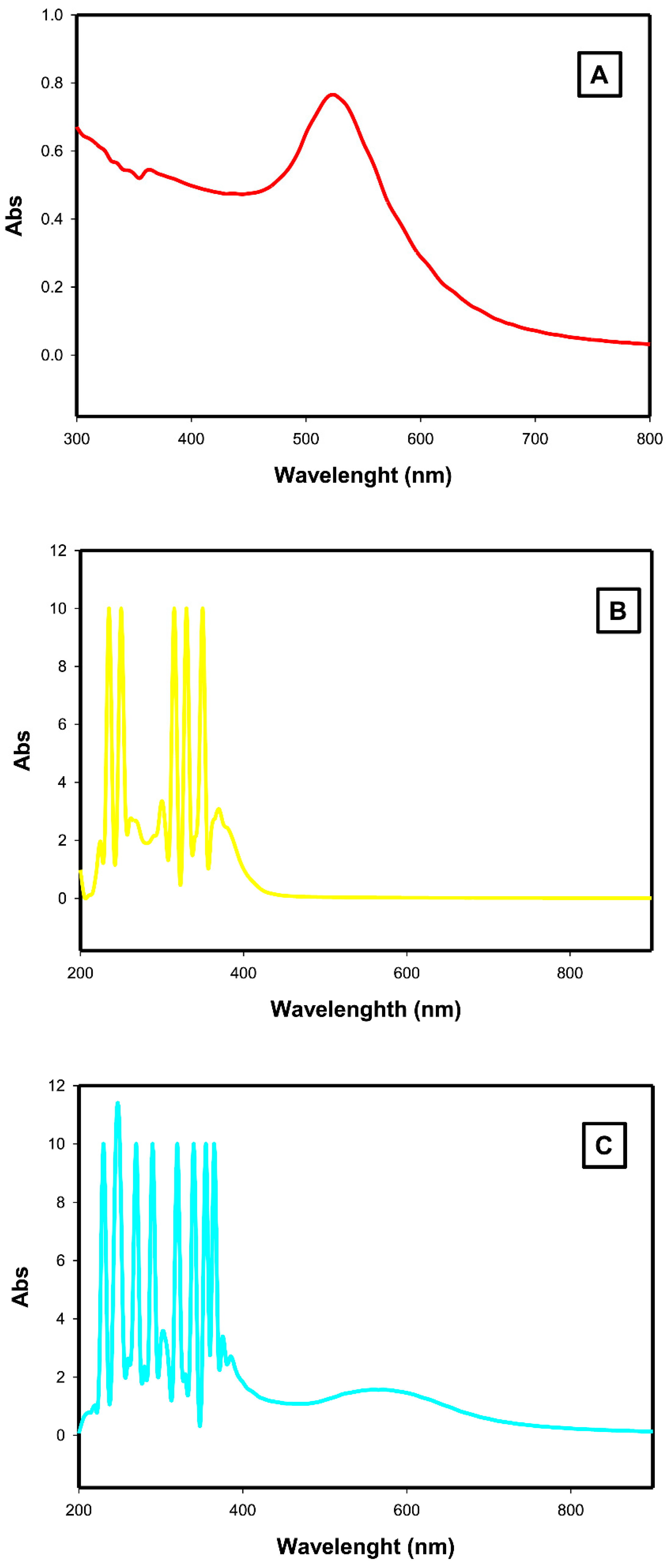
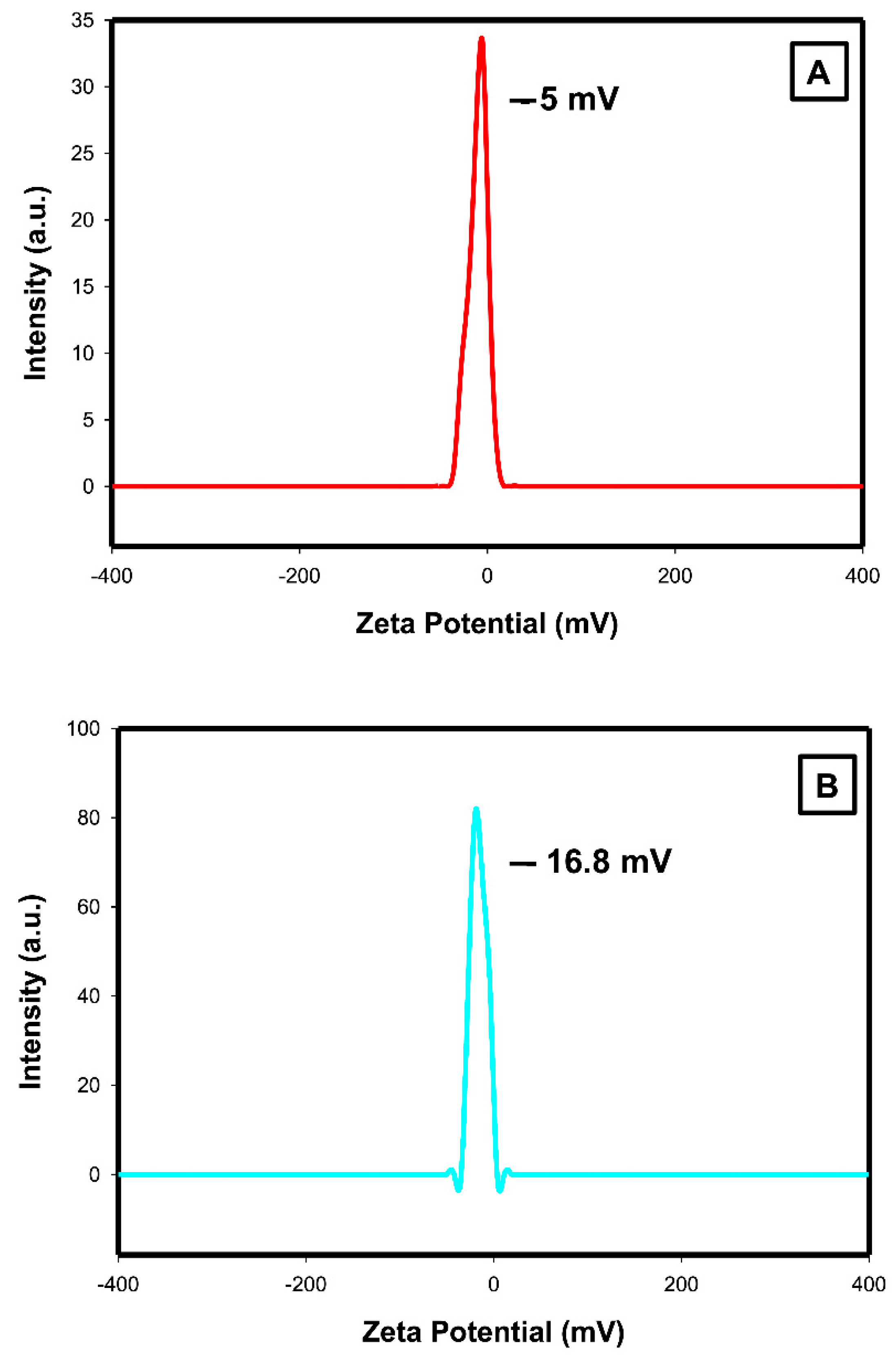
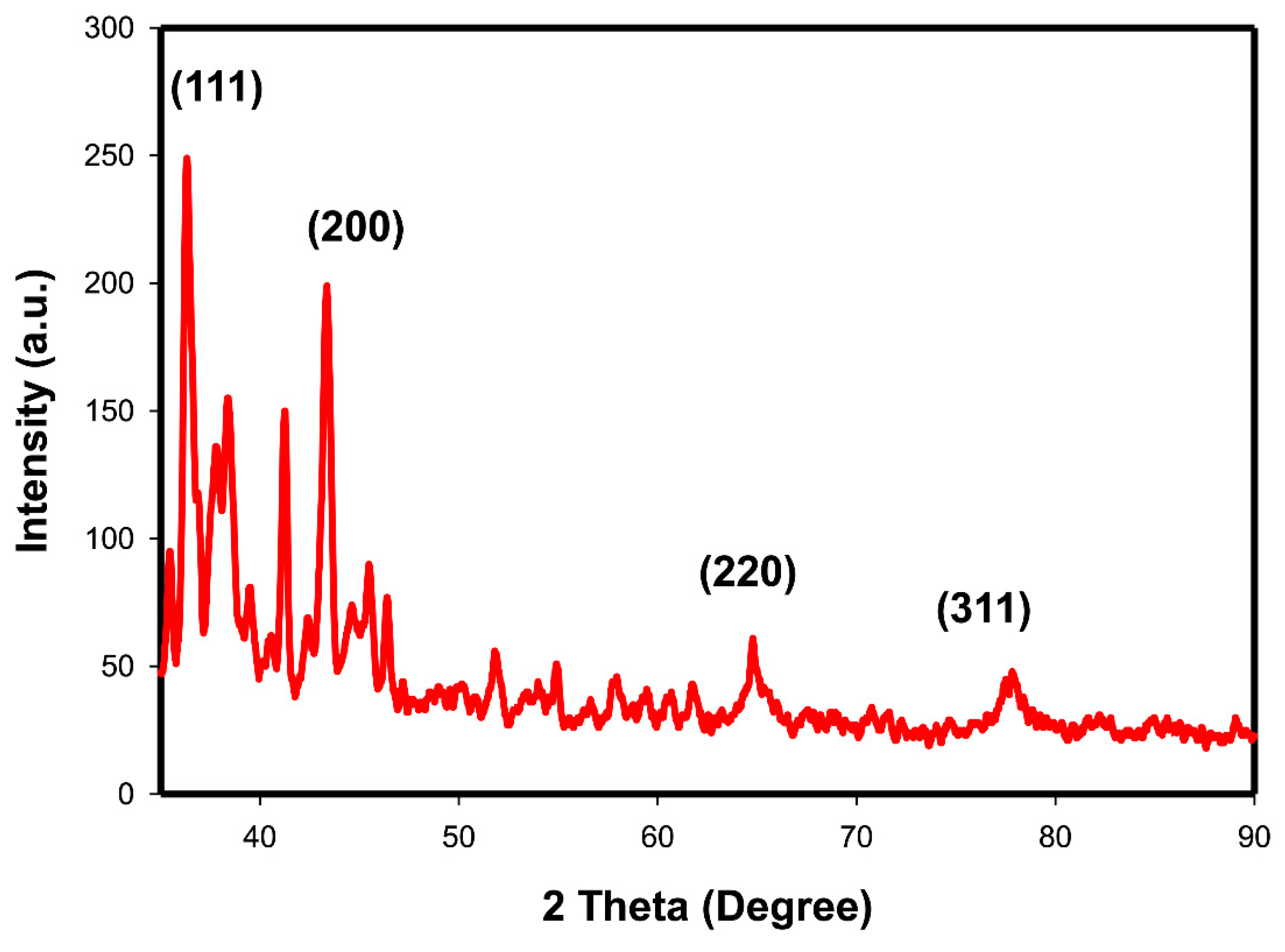
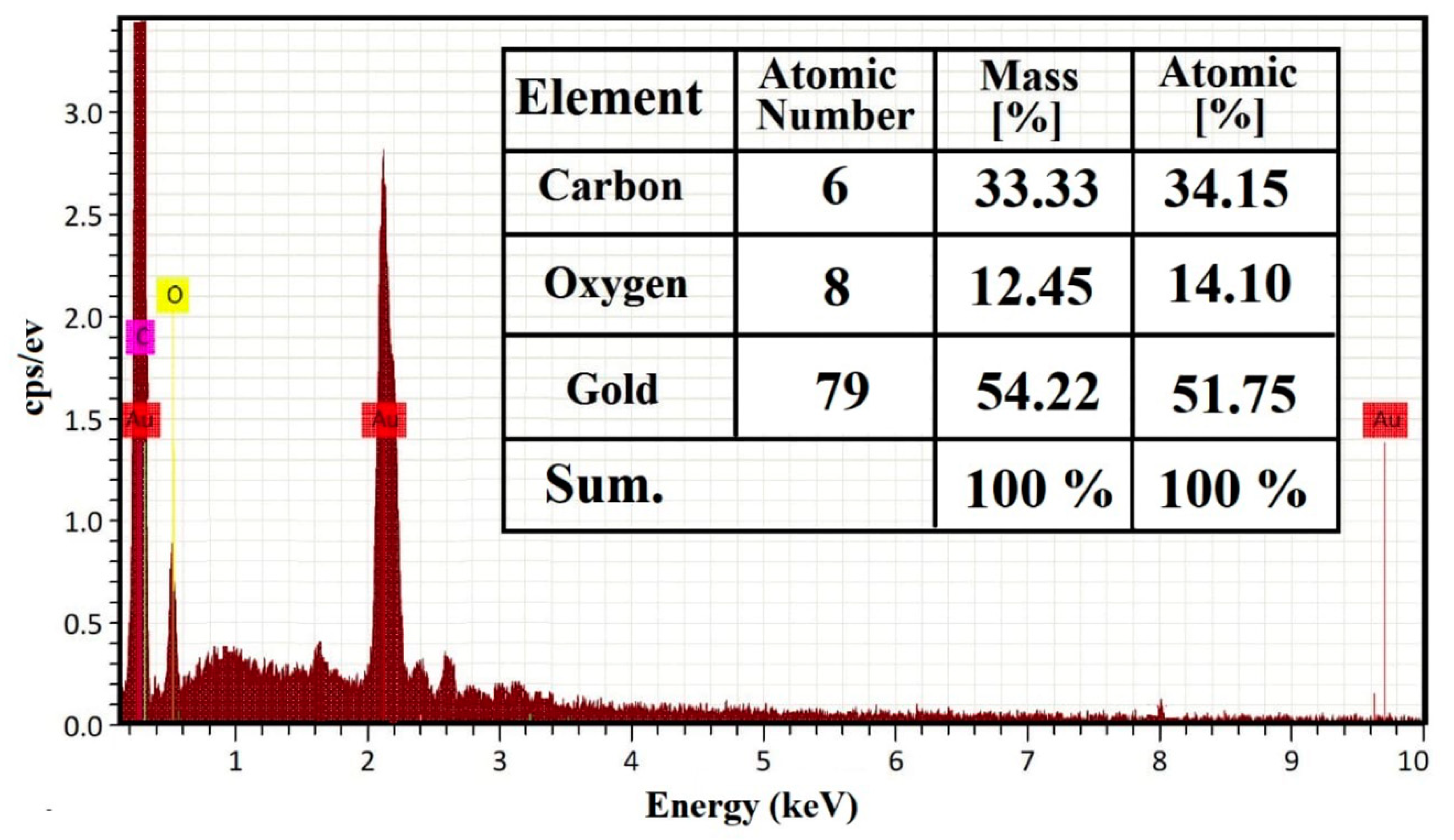

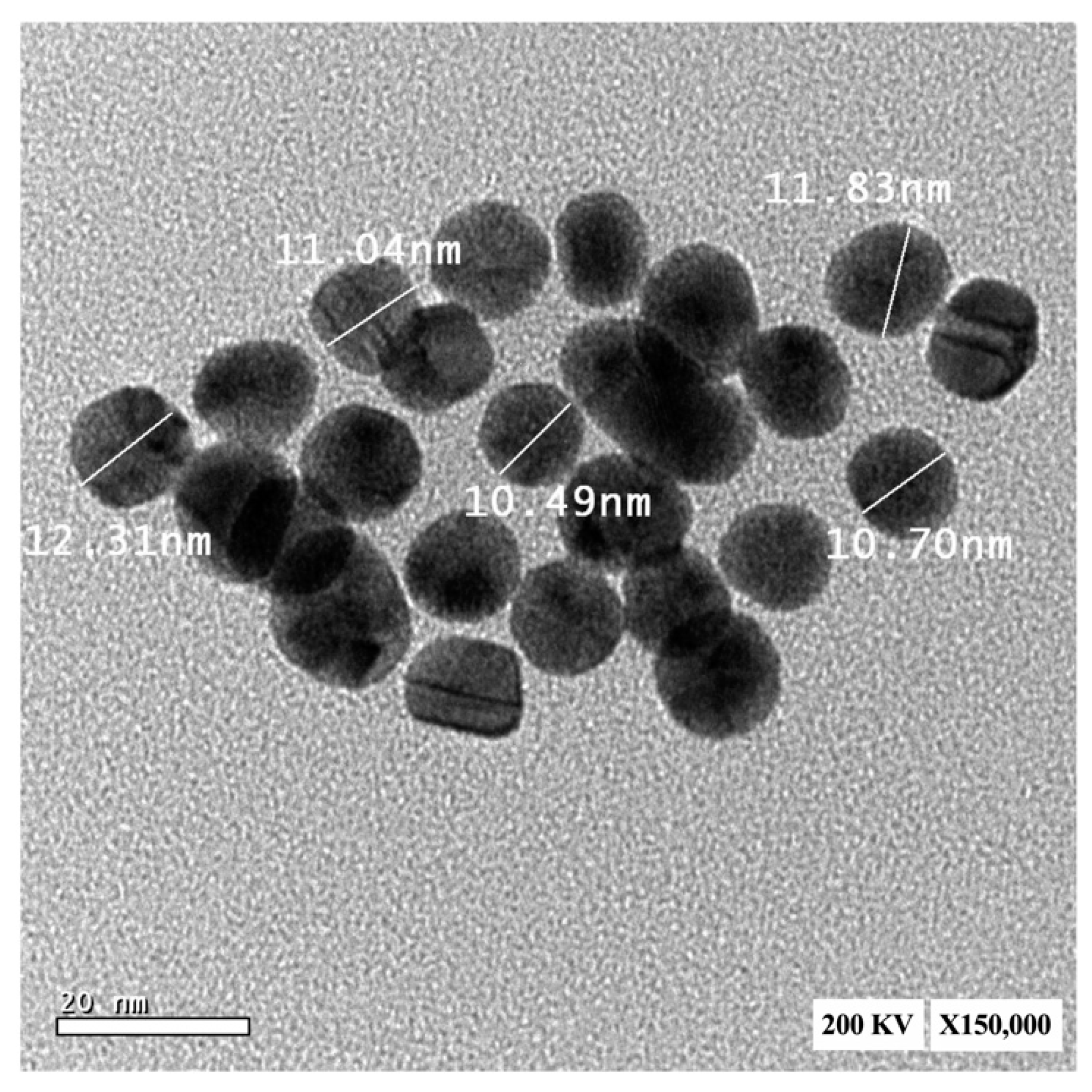
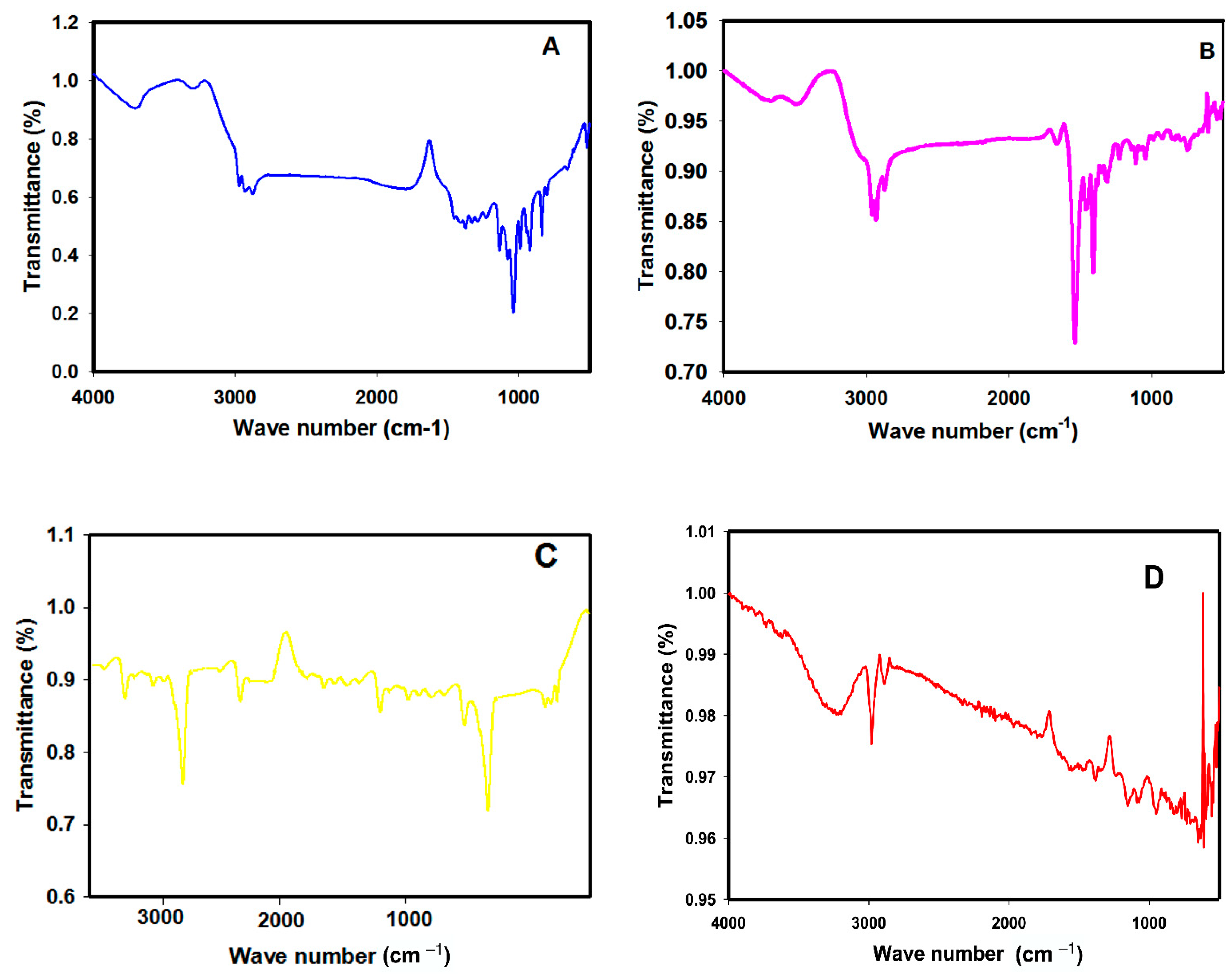
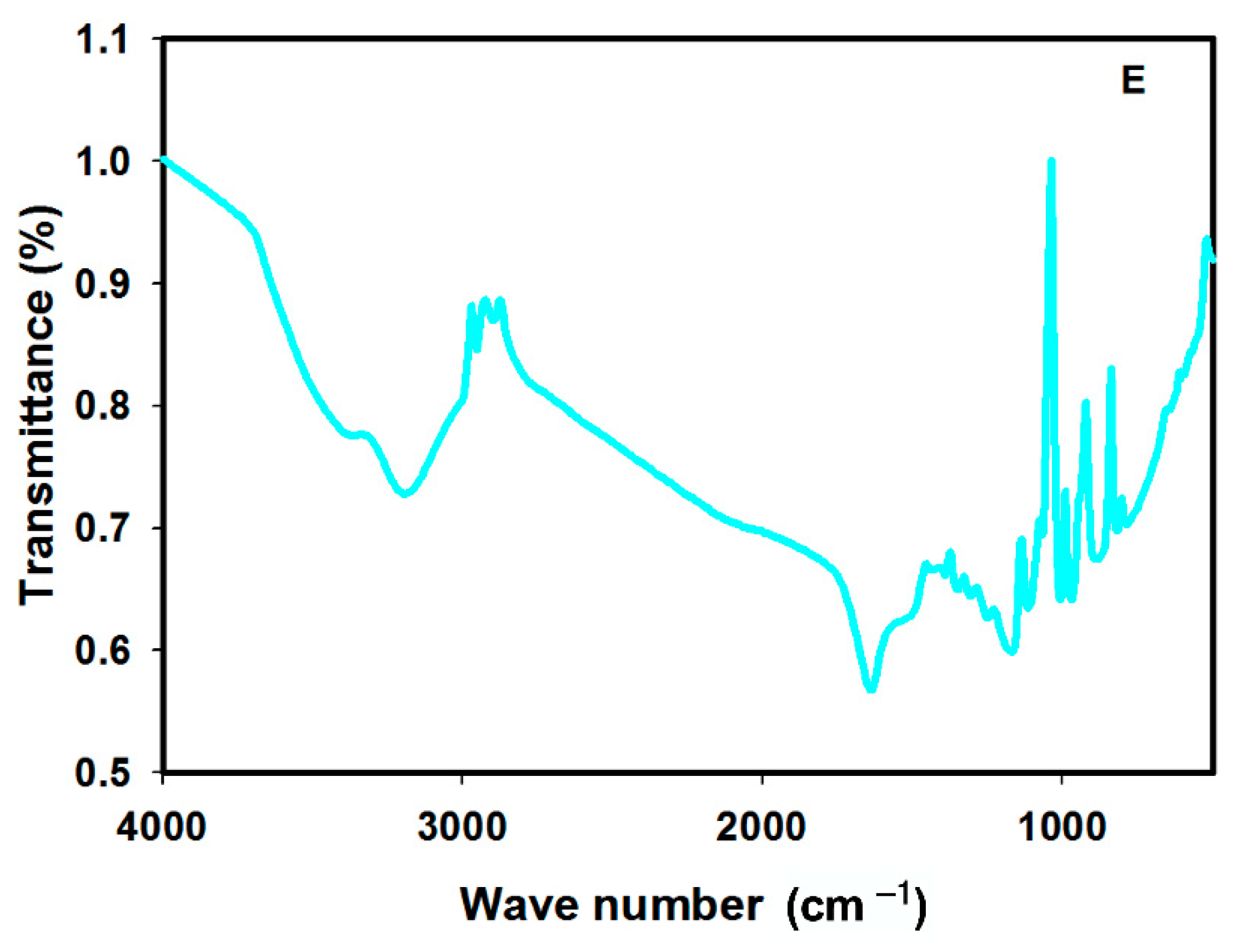
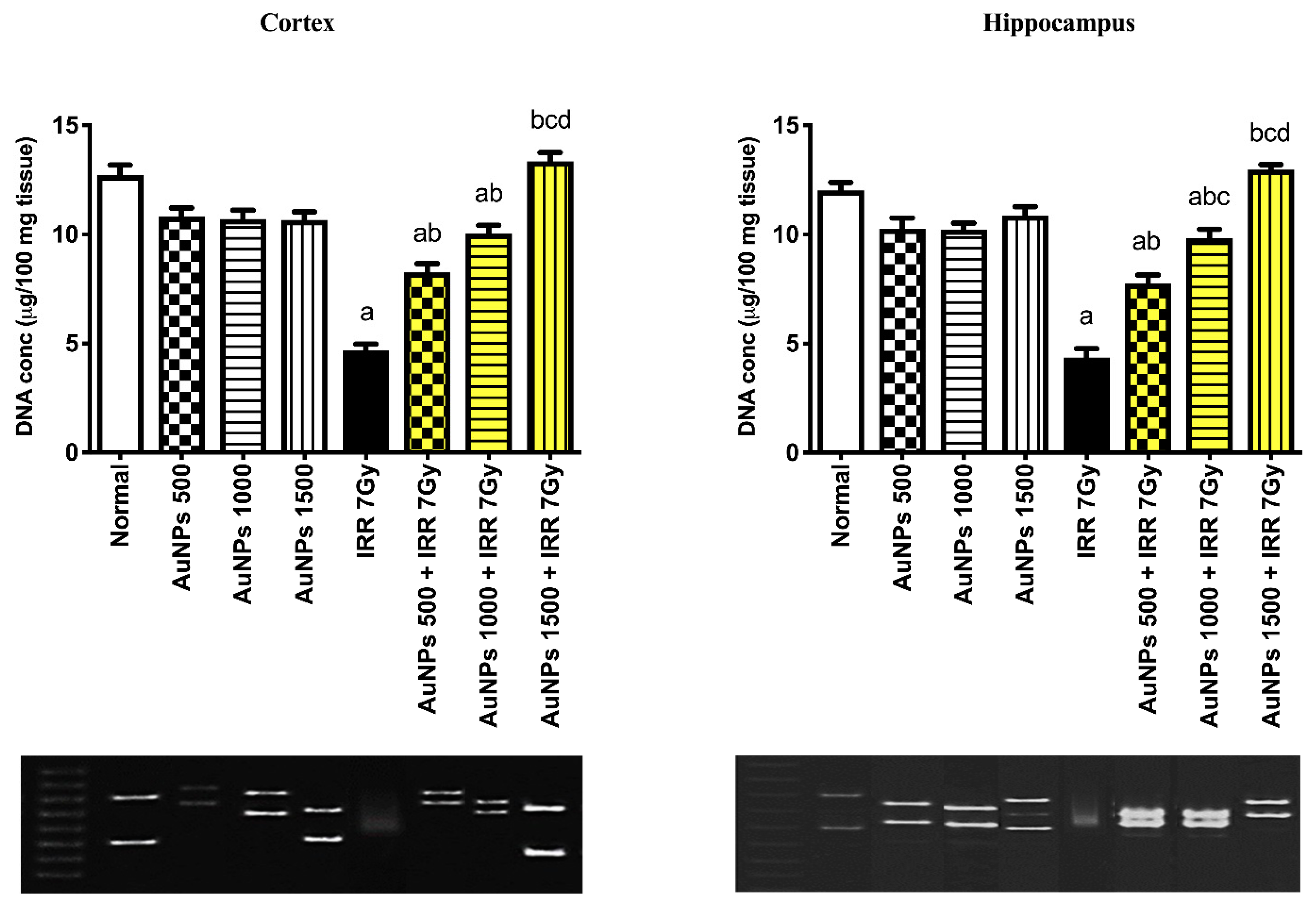
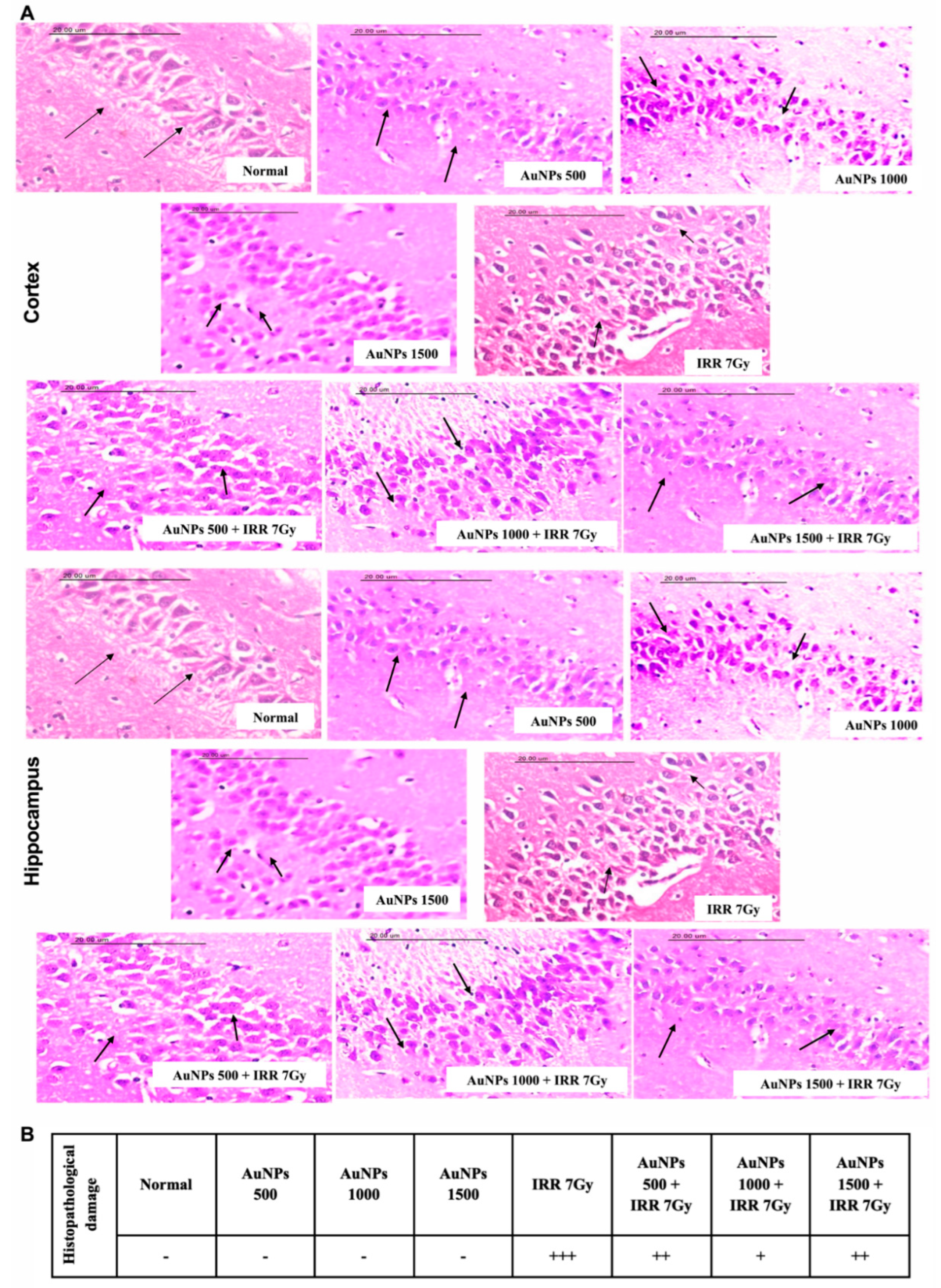
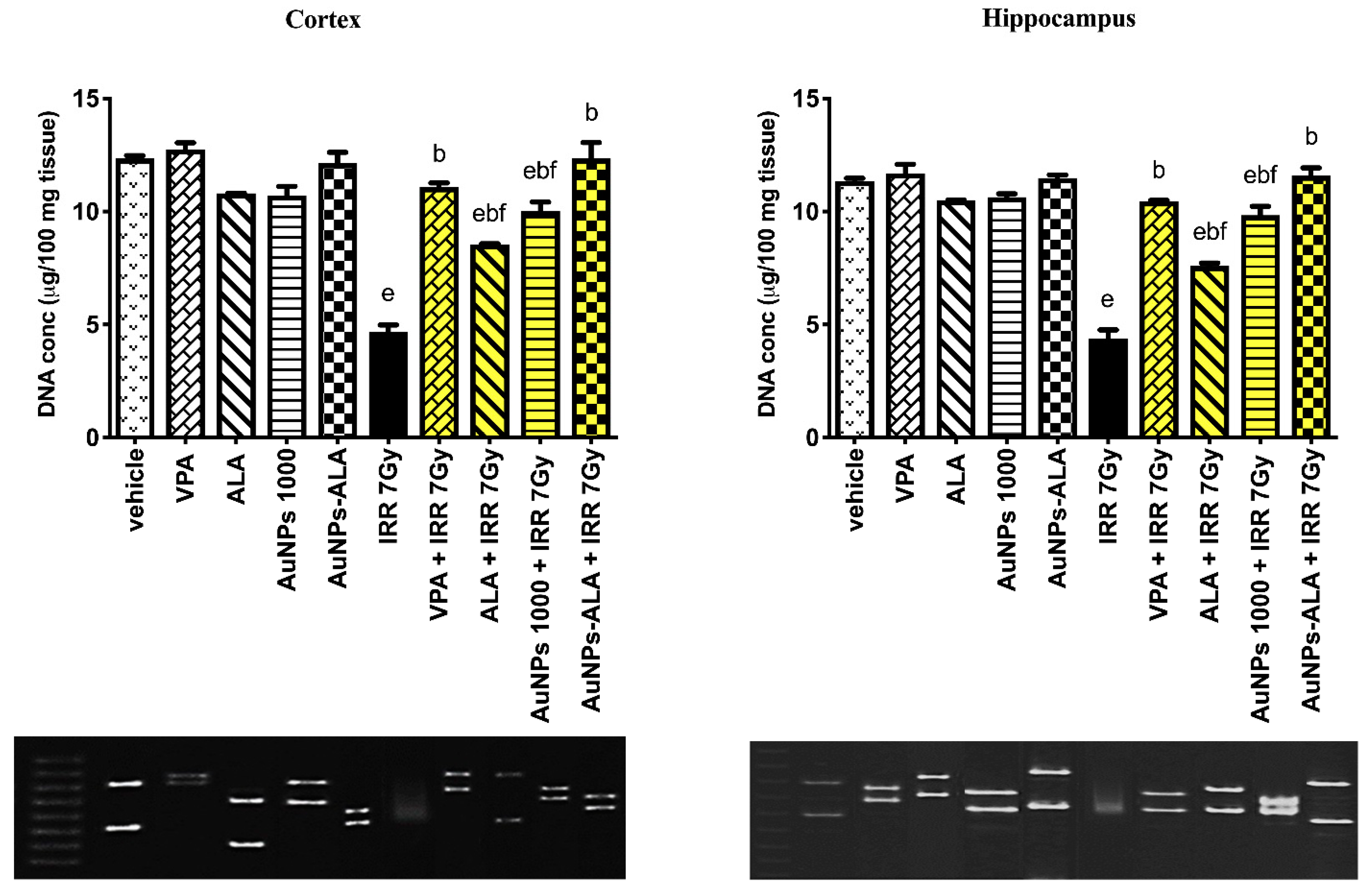
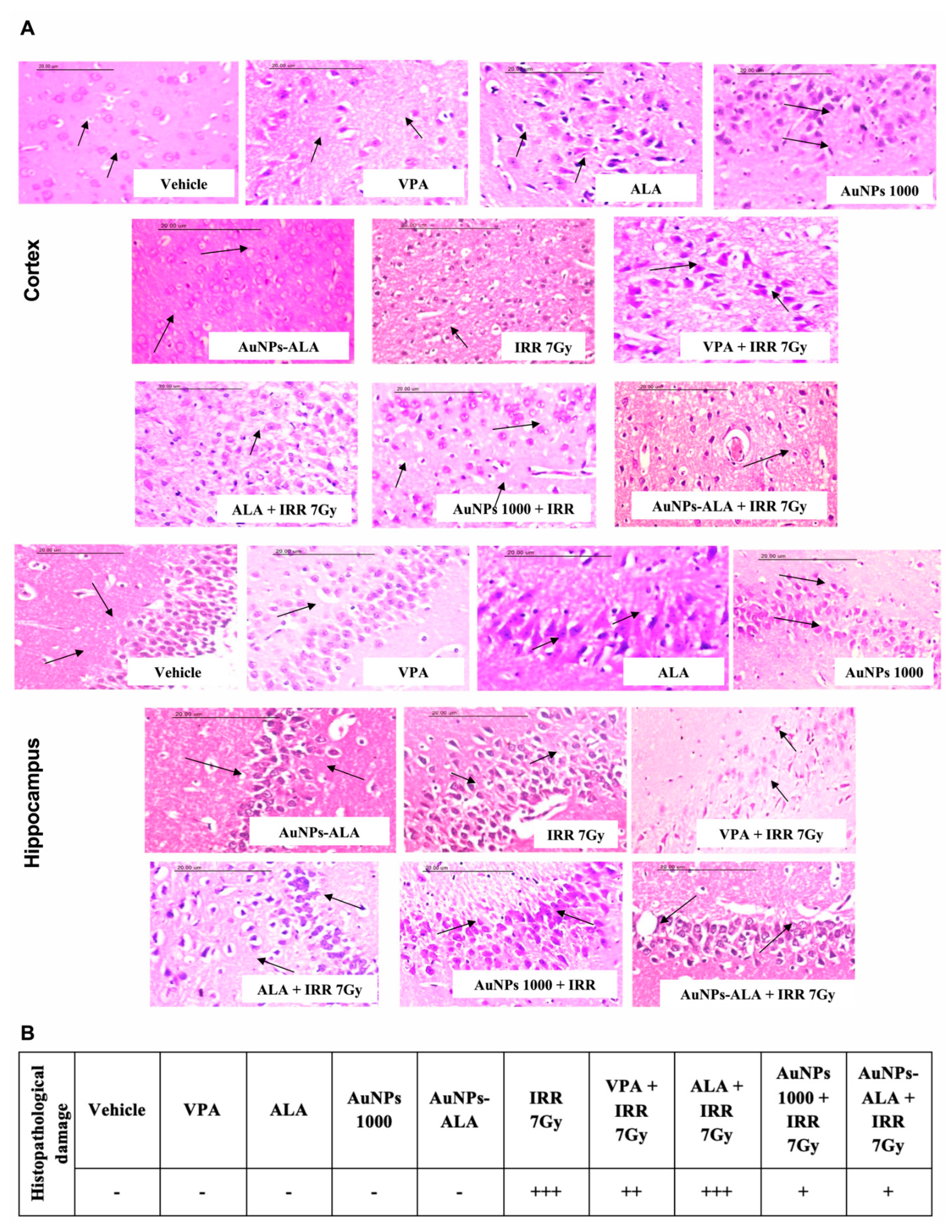
| Groups | MDA (μM/mg Protein) | GPX (nmol/mg Protein) | ||
|---|---|---|---|---|
| Cortex | Hippocampus | Cortex | Hippocampus | |
| Normal | 0.561 ± 0.006 | 0.384 ± 0.002 | 2.527 ± 0.014 | 1.688 ± 0.022 |
| IRR 7Gy | 4.053 ± 0.166 a | 3.277 ± 0.198 a | 0.602 ± 0.037 a | 0.409 ± 0.067 a |
| AuNPs 500 | 0.600 ± 0.013 | 0.492 ± 0.022 | 2.610 ± 0.089 | 1.762 ± 0.031 |
| AuNPs 1000 | 0.560 ± 0.011 | 0.447 ± 0.0142 | 2.605 ± 0.079 | 1.728 ± 0.014 |
| AuNPs 1500 | 0.911 ± 0.027 a | 0.912 ± 0.013 a | 1.916 ± 0.024 a | 1.348 ± 0.032 a |
| AuNPs 500 + IRR 7Gy | 2.779 ± 0.029 ab | 2.370 ± 0.103 ab | 1.473 ± 0.075 ab | 0.854 ± 0.0119 ab |
| AuNPs 1000 + IRR 7Gy | 1.771 ± 0.023 abc | 1.322 ± 0.020 abc | 2.441 ± 0.024 bc | 1.618 ± 0.024 bc |
| AuNPs 1500 + IRR 7Gy | 2.297 ± 0.021 abcd | 1.453 ± 0.012 abc | 1.803 ± 0.020 abd | 0.872 ± 0.020 abd |
| Groups | MDA (μM/mg Protein) | GPX (nmol/mg Protein) | ||
|---|---|---|---|---|
| Cortex | Hippocampus | Cortex | Hippocampus | |
| Vehicle | 0.628 ± 0.023 | 0.426 ± 0.05 | 1.754 ± 0.043 | 1.548 ± 0.028 |
| VPA | 0.579 ± 0.003 | 0.394 ± 0.007 | 2.569 ± 0.030 e | 1.756 ± 0.013 |
| ALA | 0.570 ± 0.002 | 0.377 ± 0.005 | 2.596 ± 0.025 e | 1.818 ± 0.024 |
| AuNPs 1000 | 0.560 ± 0.011 | 0.447 ± 0.014 | 2.605 ± 0.079 e | 1.728 ± 0.014 |
| AuNPs-ALA | 0.642 ± 0.025 | 0.427 ± 0.070 | 1.753 ± 0.034 | 1.547 ± 0.079 |
| IRR 7Gy | 4.053 ± 0.166 e | 3.277 ± 0.198 e | 0.602 ± 0.037 e | 0.409 ± 0.067 e |
| VPA + IRR 7Gy | 0.610 ± 0.032 b | 0.433 ± 0.028 b | 3.627 ± 0.184 ebf | 2.978 ± 0.097 ebf |
| ALA + IRR 7Gy | 0.646 ± 0.045 b | 0.516 ± 0.042 b | 2.474 ± 0.020 ebf | 1.472 ± 0.055 b |
| AuNPs 1000 + IRR 7Gy | 1.771 ± 0.023 ebf | 1.322 ± 0.020 ebf | 2.441 ± 0.024 ebf | 1.618 ± 0.024 b |
| AuNPs-ALA + IRR 7Gy | 0.718 ± 0.025 b | 0.361 ± 0.035 b | 1.718 ± 0.018 b | 1.702 ± 0.039 b |
Publisher’s Note: MDPI stays neutral with regard to jurisdictional claims in published maps and institutional affiliations. |
© 2022 by the authors. Licensee MDPI, Basel, Switzerland. This article is an open access article distributed under the terms and conditions of the Creative Commons Attribution (CC BY) license (https://creativecommons.org/licenses/by/4.0/).
Share and Cite
Abdelkader, N.F.; El-Batal, A.I.; Amin, Y.M.; Hawas, A.M.; Hassan, S.H.M.; Eid, N.I. Neuroprotective Effect of Gold Nanoparticles and Alpha-Lipoic Acid Mixture against Radiation-Induced Brain Damage in Rats. Int. J. Mol. Sci. 2022, 23, 9640. https://doi.org/10.3390/ijms23179640
Abdelkader NF, El-Batal AI, Amin YM, Hawas AM, Hassan SHM, Eid NI. Neuroprotective Effect of Gold Nanoparticles and Alpha-Lipoic Acid Mixture against Radiation-Induced Brain Damage in Rats. International Journal of Molecular Sciences. 2022; 23(17):9640. https://doi.org/10.3390/ijms23179640
Chicago/Turabian StyleAbdelkader, Noha F., Ahmed I. El-Batal, Yara M. Amin, Asrar M. Hawas, Seham H. M. Hassan, and Nihad I. Eid. 2022. "Neuroprotective Effect of Gold Nanoparticles and Alpha-Lipoic Acid Mixture against Radiation-Induced Brain Damage in Rats" International Journal of Molecular Sciences 23, no. 17: 9640. https://doi.org/10.3390/ijms23179640
APA StyleAbdelkader, N. F., El-Batal, A. I., Amin, Y. M., Hawas, A. M., Hassan, S. H. M., & Eid, N. I. (2022). Neuroprotective Effect of Gold Nanoparticles and Alpha-Lipoic Acid Mixture against Radiation-Induced Brain Damage in Rats. International Journal of Molecular Sciences, 23(17), 9640. https://doi.org/10.3390/ijms23179640






